Area rugs can be an excellent addition to any room. They add color, texture, and warmth to a space and help tie different room elements together. However, choosing and laying an area rug can be tricky, and people must correct some common mistakes. This article will discuss some of these mistakes and how to avoid them.
When installing rugs, we have already brought you the knowledge in a single awesome article a few months back. If you have missed that valuable article, you can read it by clicking the link below. Once you have read it, you may avoid choosing the size and laying your rug. However, we have mentioned the common mistakes that every homeowner makes when laying a rug.
Faber Rug has provided premium carpets and expert installation for any home or office in New England, United States, for generations. If you are not confident about choosing and laying your area rug correctly to improve the style of your home or don’t have time to do these things, feel free to obtain the hassle-free services of Faber Rug store at 19 Central Street, Wellesley, MA 02482. Our installers will assist our clients with rug installation services. The Faber team is responsible for moving your furniture, removal of the old carpet, and installing your new carpet. Also, you can shop for thousands of rugs in different categories at our store. Visit us to solve any rug matters. We are the one-stop solution for quality carpets and installation throughout New England.
Our experts never make the following mistakes, from choosing the best rug to finalizing the installation. Keep going through the article and ensure you are doing everything right. Good luck.
One of the most common mistakes people make when choosing an area rug is selecting the wrong size. A rug that is too small can make a room look disjointed and awkward, while a rug that is too large can overwhelm a space and make it feel crowded.
To avoid this mistake, measure your room and consider the placement of your furniture. A good rule of thumb is to choose a rug that is large enough to fit all your furniture or at least large enough to anchor the main seating area. If you have a smaller space, a rug that is just slightly larger than your furniture can work well.
However, the correct rug size depends on where you want to lay your carpet. Here is some good news! We have many articles that describe the correct way of choosing the correct rug size for each area of your home. Some may have read them, if not remember, you still can! Click the suitable link below, read the article, and please follow along.
How to pick the best Hallway runner rugs
Incredible tips for selecting the best kitchen rugs
Baby-Safe Rugs: Choosing Soft and Non-Toxic Options for Your Little One’s Space
Decorating your modern home with a vintage rug
Decorating a bedroom with rugs
The articles mentioned above discuss different moments and times when homeowners need help choosing the correct rug size. Review the best-fitting article for you. It will be beneficial for you. If you need further assistance, feel free to contact us anytime.

Another mistake people must correct is choosing the correct material for their rug. Different materials have different textures, durability, and maintenance requirements, so choosing the right one is essential.
For example, if you have kids or pets, a rug made of natural fibers may be the best fit. This was written about earlier. We have displayed the link below so you can easily review the article right away.
Baby-Safe Rugs: Choosing Soft and Non-Toxic Options for Your Little One’s Space
On the other hand, if you want a luxurious feel, a thread or silk rug may be a better choice. Also, choosing a handmade Indian rug will do the work perfectly. Read the following 2 articles that describe why you should buy an Indian rug for your home. At Faber Rug store, we have the highest quality Indian rugs with different styles to fit your need. Please call us directly if you need further help or have any inquiries.
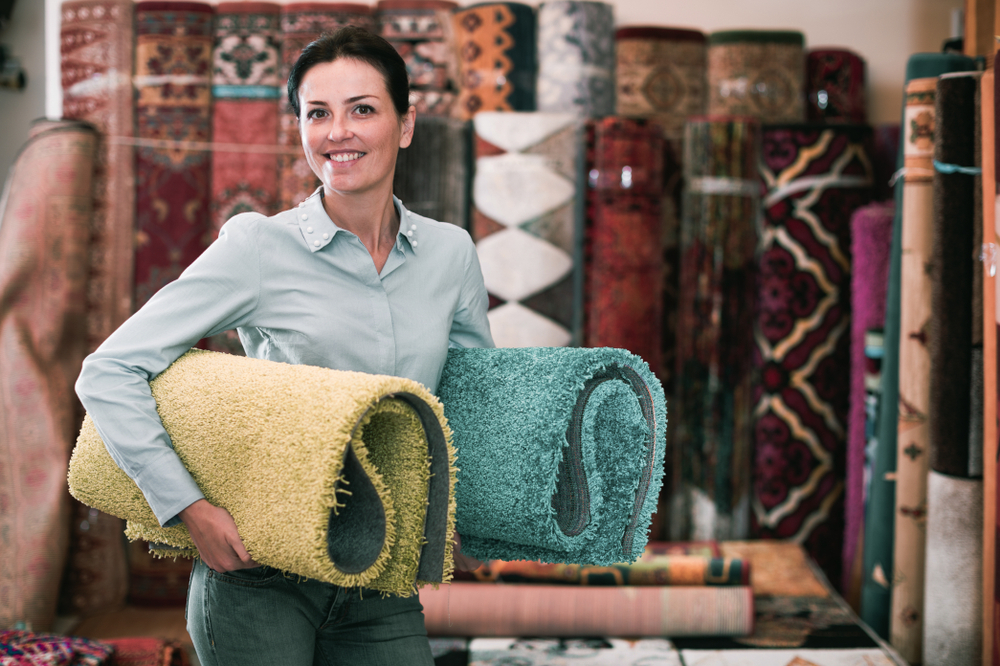
When choosing an area rug, it’s essential to consider the overall style of your room. A carpet that clashes with the rest of your decor can be distracting and make the space feel disjointed.
To avoid this mistake, choose a rug that complements the colors and patterns in your room. If you have a lot of bold patterns or colors, a solid-colored rug can help to balance the space. A patterned rug can add interest and texture if you have a more neutral room.
Once you have chosen the perfect rug, it’s important to lay it correctly. Placing the carpet in the right spot can make the room feel balanced and comfortable.
A common mistake is placing the rug too close to the wall. Instead, try to leave a few inches of space between the rug and the wall to create a visual border around the room. If you have a smaller rug, consider placing it under a coffee table or furniture to anchor the space.
Finally, many people need to use a rug pad. Rug pads help to prevent the rug from slipping and sliding and can also help to protect your floors from scratches and wear. Make sure to choose a rug pad slightly smaller than your rug, about one and a half inches smaller all the way around and consider using a pad with extra cushioning for added comfort.
In one of our previous articles, we explained about buying the correct rug pad. Click on the link below and review the article for further clarification.
Stay in touch with our blog and keep your rug knowledge updated. If you have any questions about buying a rug for your home, contact us immediately. Our experts are always ready to assist you with choosing the best rug, measuring it, and installing it.
Please E-mail us any questions you may have:- contact@faberrug.com
Shop at our store:-19 Central Street, Wellesley, MA 02482
Call us:- (781) 235-5996
Colors play an interesting role in every moment of our life. Specific colors are associated with everyday activities, memories, dreams, etc. We react a certain way when we see them depending on whether we like that particular color. A color or a combination of colors is a powerful communication tool to demonstrate many things that one can’t express using words or phrases. As a result, colors are used in many instances to signal actions, influence mood, and even influence psychological and physiological reactions. Hence, designers in every relevant field use colors carefully to create beautiful, stunning works of art. The same situation is witnessed in the rug industry. Rug color ranges start from neutral colors, but you may notice a wide range of colorful rugs. Yes, rugs are within a wide range of colors and patterns, and people buy them individually or with a few coordinating pieces at a time. That’s why it is important to purchase colorful rugs for your home.
Cultures inspire the art of rugs. These cultures have a unique identity, as a brand does. Even though some of them are quite ancient, they still manage to awe people, especially the next generation, who admire these colorful designs and prefer to buy them to make their living spaces more artistic and beautiful.
No doubt they also look at modern rug designs. Modern colorful rug designs better personalize your space, making it appealing and welcoming. So, both antique and contemporary rugs become good choices when they are colorful. They equally bring contrast to the room décor.
Colorful rugs accentuate portions of a room and add to the mood and ambiance of the interior decoration by harmonizing colors and shapes. Choosing the right rug color may fix your mood, nourish you with good thoughts, and impress your guests. Also, colorful rugs bring light and variety into a neutral space that needs some energy to make the space have character. These qualities have made them an important asset in past, present, and future interior designs.
We have discussed the texture, pattern, material, pile, and more you can choose when buying a rug. If you have missed those, we highly recommend you read them after reviewing this article. We will include the links below for you.
No doubt, colorful rugs are beautiful. But, when decorating your home with them, you must pay attention to the color tones, vibe, and amount of light. It would be best to keep their bold, bright, bravado features to make your space look invigorating. Follow this article about decorating with colorful, bold, bright rugs from any culture to create an eye-catching cozy look in your home.

First, avoid getting unnecessary pressure when choosing a colorful rug for your home. Figuring out how to choose a rug style for your living area is relatively easy and interesting. All you need to do is study well and lock in the right design to fit your space.
Size matters because the rug, its color, and the patterns can instantly define or change a room’s atmosphere. We have a dedicated article about measuring rug sizes. Click here to view that article to collect some additional knowledge on this. Once you have measured the dimensions and decided how to carpet the room, you can decide on the style.
Keep the following relationships in mind when choosing colorful rugs for your space.
A rug is a magical thing. You can even give the illusion of a large area by choosing a light-colored rug for your small room. Focus on natural hues for this. If you have a small-sized room, consider purchasing this rug since it may complement both modern and boho interiors. Faber Rug has a wide range of light-colored rugs. Visit us at Faber Rug Company in Wellesley, Massachusetts, or Contact Us for more information.
A dark-colored rug will work better when you have a large, open-plan room. It acts as a focal point to define your space. Also, the use of dark and rich color palettes is increasing in popularity. For example, you can use blue as the color of the rug and then add in furniture and accessories. You can start shopping for rugs with some of our mind-blowing blues for your large room at Faber Rug Company in Wellesley, Massachusetts.
Make sure any rug you’re considering complements your sense of style. As an example, busy patterns can be overwhelming in small spaces.
· If you’re decorating a small room, stick to light, solid colors for your decor.
· If you can’t endure the thought of your space looking boring without any texture, you can select a patterned rug, as long as you opt for a large design. Avoid tight, repeating graphics and choose airy designs with plenty of space between them.
Considering the atmosphere when buying a rug is paramount, especially when purchasing an area rug for your space. This is because a rug can influence the overall atmosphere of your room. Colorful rugs can set the mood. So, it is essential to understand the atmosphere and match the area rug color. Once you are done, follow these tips to make it a success.
1. Dark and natural colors make your living room feel cozy and luxurious. They are calming and provide an intimate feeling. These hues capture eyes at first sight and let them relax.
2. Light natural colors can be used to achieve more light and airy space.
3. Use cool-colored rugs for the places you need to look sunny and bright. Those cool-colored rugs will add a feeling of serenity to your room.
4. Pastel blue and sage green rugs work best to form a calm environment.
5. Yellow, orange, or red-colored rugs add warmth to your space.
On the other hand, multi-colored rugs with patterns are perfect for art deco living styles. You can read the previous articles mentioned below if you need to be made aware of the art deco living style.
Vibrant, colorful rugs are unique and full of personality and will create an atmosphere that feels uplifting and fun. You can shop these colorful rugs from different parts of the world, including Indian rugs, at Faber Rug Company in Wellesley, Massachusetts. We are always ready to let you go through our selection of hand-picked colorful rugs. Come take a peek! We are always ready to guide you in choosing carpets for your home or business.
When you hear about products made in India, authenticity comes to mind. Around the world, the name “India” is the place for quality arts and crafts, decor, or food. That unique identity originated a long ago, in the times of the king’s ruling the Indian empire. The Indian empire was governed by different kings and rulers who belonged to many cultural practices. The later Indian culture combined those cultures, where most people were embraced with love. The world has the same view about Indian rugs. Most people love that combination of cultures in Indian products. Please review the following linked article for more information.
The industry in India dates to the 16th century. Since then, the industry has spread over India to many provinces like Jammu & Kashmir, Himachal Pradesh, Punjab, Haryana, Madhya Pradesh, Rajasthan, Gujarat, Kerala, Andhra Pradesh, Telangana, Odisha, Uttar Pradesh, and more. This has made India the largest exporter of carpets and an icon among global carpet producers.
Interestingly, India is an unrivaled producer of tufted carpets and hand-knotted rugs. Over two million people in India are engaged in carpet weaving. At the same time, there is also a large-scale carpet industry where advanced and expensive machines are used to produce them in very high quantities.
Although Indian rugs are more familiar with traditional and oriental looks with bold colors and patterns, they have now handpicked modern designs that fit the 21st century. A wide range of fibers is used to create these types of floor coverings, and you can still shop these incredible Indian rugs at the Faber Rug store in Wellesley, Massachusetts. Keep going through the article further and learn how to choose the best Indian rug to match your home. Remember to review our rug collections displayed online by clicking the links below.

Choosing suitable rugs is the most interesting part of home decor. It is essential to do when you need luxury flooring, soft footing, and an attractive carpet in your home. You may have heard the significance of Indian rugs to satisfy the above needs in any home. Here is some proof that will help you choose the proper Indian rug.
A beautiful Indian rug is made by investing time, and craftsmanship; then a unique piece of art is produced. These beloved rugs have exceptional design and quality. The following factors have made them renowned worldwide.
The design of a rug a consumer prefers may differ according to their proposed purpose. In that case, Indian artisans have become flexible to cater to everyone’s needs. Whether you need a carpet for your private residence, hotel, restaurant, corporate office, or elsewhere, you can select the most suitable design from Faber’s products. When selecting, it is better to go for Indian rugs because they have a wide variety of products that can be chosen precisely as you wish. Faber’s carries a range of designs and colors ranging from bright hues to light tones. That’s why Faber Rug offers you the world’s most sought-after collection of rugs from India. Also, you can choose any colors, patterns, and cutting-edge or contemporary designs at Faber Rug to satisfy your unique needs, tastes, specifications, and expectations. Faber can fulfill customers’ requests, create custom rugs, or choose from a one-of-a-kind inventory.
India’s highly experienced rug weavers put their perfect skills to use in creating a final product. Compared to the other rug types in the world, these rugs have the most knot count in a single rug, which increases durability and comfort. Therefore, they have become the paragon of luxury flooring among the top interior designers and rug collectors. The sense of contentment and warmth is very high in Indian rugs. The stringent quality control at every stage of rug production that they maintain is the key to the extreme durability and quality crafted pieces exported from this beautiful land.
Many homes decorative products are quite easy and interesting to purchase but may take some help to maintain. Indian rugs are tightly knotted, as mentioned in the above section, and very dense. They conceal dust, grime, and lint. So, it is optional to wash and clean regularly, so when it needs to be cleaned, feel at ease that these pieces will come back to life with not much effort on your part.
The premium quality of these types of rugs depends on the material used. The most impressive thing about these types of rugs we are talking about is that they are made using high-quality natural materials. Indian rug manufacturing enterprises provide rug artisans with the most delicate fabrics like silk, jute, and sisal. Most of these materials are high-quality and polished to derive the best output for customers. The most durable rugs are made from wool, but they can be extremely extravagant using a mix of fibers such as silk.
India is known for quality at a low cost for the consumer. As a result, the products of the country have become less expensive but with high quality. Simply put, they are cost-effective and price-worthy. So, when you are purchasing these, you can cut many costs and achieve a better interior design.
Faber Rug has been importing Indian rugs for decades. Many of our customers have shared good thoughts and marvelous experiences with Indian rugs. We highly recommend viewing these rugs in person to feel their quality. If you are local, you can take these beautiful rugs home for free on a trial. Peek into our incredible rug store in Wellesley, Massachusetts and we will help you choose the most fabulous rugs. You can call or email us anytime for any rug inquiries.
We look forward to assisting you in any situation. Click the link below and visit our Contact Page for more information.
Dear rug lovers. We have come across a long journey through different generations of rug stories. But I noticed we had missed this incredible art deco rug. But, no more. I just poured a cup of coffee for a fantastic article that might inspire your soul about the early 1920s.
The rug style has inspired by the famous deco movement that first appeared in France. It is a style for visual arts, architecture, and product design featuring geometric designs. Smooth shapes and modern technology are reflected by the objects in which the art deco styles were used and could be identified as a unique feature of that time. Since the style flourished until the 1950s, many of the products and constructions were created using different patterns. Those include clothes, buildings, roads, jewelry, ships, bridges, vehicles, furniture, and also rugs. The unique feature of the style at that time, just before WWI, was the modern way of creativity and craftsmanship. So, many sectors and designers embraced the style and let the creative juices flower through the decades.
As a result, art deco rugs were formed. Since art deco characteristics can be easily identified, they become popular within a few periods. After this movement, luxury, exuberance, glamour, and the modern feel began a revolution in the rug industry. The symbolic designs impressed the people then and suddenly invaded the royal and the richest places carpeted.
As well as, the bold colors, strong geometric lines, and cutting edges are still unmatched by any design style or rug culture in the world. These designs blended with some incredible fabrics bring the next level of luxury feel and look.
Although people use different colors, designs, styles, and textures, a rug design bespoke to your residence always seeks something new. Even though this rug style is from the past century, they are fascinated with contemporary fashion. So, the style follows cultural elements like motifs, iconic figurines, and decorative patterns related to the most beloved western culture. So, the style denotes a modern way that lasts centuries later by being a splendid depiction of geometric designs.
The artistic and luxurious touch given by an art deco rug made up with fine tunned geometrical patterns might not be replaced by any other rug easily. The bold contrast between each design and the majestic feel will always remind us of a modern design. As a result of futuristic cultural designs cultivated by the artists still hailing in luxury, an art deco rug for your home will give you the following key benefits.
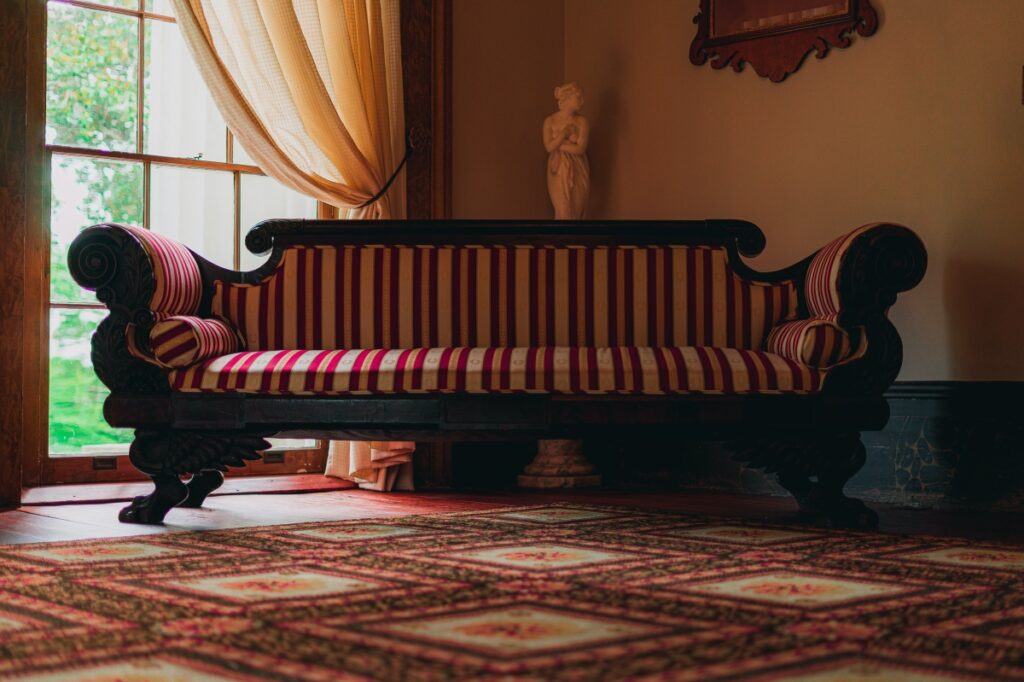
Your house’s artistic design can easily focus on deep, color-rich, vibrant colors. Emeralds, purples. Otherwise, you can choose furniture with shiny surfaces that improve the luxury look through details. It will not be hard to select some eye-catching wall styles whenever you use these rugs.
When this kind of rug is well placed in your living room, bedroom, or hallway, it carefully injects some life into the location. The soothing styles will make your home look good with as many vibrant colors as possible. Even though you have to face many climatic conditions like sunny days, dark winter days, and days of spring, the rug will perfectly deliver natural colors into your home blended by the geometric patterns and the colors.
Your house will be easy to clean. Honestly, we have discussed this hard rug cleaning operation many times and tried to give you a bunch of articles to make your rug life easy by cleaning. But, here is an unmatched tip, since art deco rugs are a type of low pile rugs, they are very easy to clean. When the fabric loops of the rug are low, we call it a low pile rug. The good news is that when the fabric loops are less, it’s easy to clean and vacuum because the pile is low and doesn’t trap a lot of debris.
Congratulations! Since these rugs contain low piles and are easy to clean, these are the best option for covering high-traffic areas like the entryway, hallway, and kitchen.
Much like dust particles don’t easily stick; an art deco rug prevents allergens from getting stuck among the fabric loops (pile). It prevents allergens from entering your home and often makes you sick.
Although low-piled rugs create a smooth surface with comfort, art deco rugs pioneer those.
We at Faber Rug Co. Inc. are always responsible for bringing you the best products. Your eye-catching floor and the comfortable step are our reward. If you have more matters to uncover, contact us as soon as possible. We are pleased to hear from you.
Do rug matters cause you problems? Visit our showroom. We provide the finest carpeting from India to the United States with reliable carpeting services over decades. Our guidance and the products will solve everything.
An area rug is the key embellishment of every house. Even the rugs are the most luxurious item to improve the home decor, and they are easy to acquire. However, different textures and sizes meet the demands of varying rug lovers. So, an area rug is kind of simple and often much smaller than the room size, unlike wall-to-wall carpets that span the entire room. The most popular sizes are 6×9, 8×10, 9×12, 10×14 and 12×15. In order to get everything out of your rug, you must use proper rug padding under your area rug. You will only get the luxury benefits of your area rug if you have chosen the best rug padding, so that’s why you need to know the fundamental stages and tips derived from experience and knowledge about how to buy a rug pad. Before getting into that, shall we know the actual benefits of having a rug pad for your area rug?
Rugs undoubtedly add comfort, a luxurious look, and essential protection to your floor. So, why do we need rug padding when rugs protect your floor?
Hiding underneath the lovely luxurious Oriental, Modern, Synthetic, and every kind of rug discovered around the world, rug padding helps the carpet wear better, it provides a soft cushion to walk on and it keeps the rug from sliding.
Whenever you use a rug pad underneath the rug, it helps to keep your foot stable without sliding, slipping, or moving away. The rug pad helps your rug to stay stable without getting creases from shrinking and crushing. Plus, rug pads are an incredible invention to shield your floors over the long haul from abrasive wear. Keep reading!
No matter where the rug is set (on carpet or wood, etc.), if a pad is lying underneath, it prevents slipping, sliding, or pulling. This will be very valuable when carpeting wooden or ceramic staircases with beautiful designs but with slippery backings and when there are elders or children in your home.
Very important! A pad prevents dye transfer, fading, staining, and scratching onto floors or carpeting underneath. Likewise, a pad prolongs the life of your rug by preventing the fibers from crushing. This pad is a buffer between the hard surface below and the rug above. It absorbs much of the grinding action from footsteps and works to protect against carpet wear.
A pad allows easy vacuuming and fine sand particles to filter through the carpet rather than collect inside. When your rug is set in a high-traffic area, it usually gets sand particles between the rug and the floor. You are already aware that cleaning or vacuuming rugs isn’t easy, so rug padding can help you reduce cleaning times and make cleaning easy.
These benefits are not easily derived through whatever rug pad you purchase from the market. However, if you are wise enough to buy proper rug padding, all comfort is for yours.

A rug pad is a layer of fabric between the surface of your flooring and beneath the backing of an area rug or large room-sized carpet. Here we pinpoint the essential tips you must consider when buying your rugs.
The rug pad must be about an inch less than your rug on all four sides. So if your rug size measures 8’x10′, the rug pad size should be 7’10” x9’10”, two inches less on each dimension, equaling one inch overall. Four sides. If you are unsure about the size when you go shopping for the rug, better to buy a few inches larger, and then you can use scissors to make it perfectly fit.
The benefits mentioned earlier: prevent slipping, protect the rug, and add comfort. All this depends on the thickness of your rug pad that you are laying beneath your incredible rug. That’s why you need to refer to this type of article that is informative and explains about how to buy a rug pad. Don’t buy to thick of a pad or to slim of a pad. A proper rug pad that offers the shared benefits should be ¼-inch thick. A thick rug pad adds more height which can cause many problems. A ¼-inch rug pad adds the right amount of padding, while a thin rug feels slightly stouter. However, thickness differs from the various styles and types of rug pads on the market. Let’s have a look.
There are three main types of rug pads that you can purchase from the market. They are grip-only, cushioned, and grip-plus-cushioned. So, how do you choose the one you want?
Grip-only pads are the thinnest style and are great for outdoor use because they don’t absorb moisture. They are also perfect for use in high-traffic areas of your home and where you want your rug to have a lower profile, such as under a door opening.
The cushion pad is ideal for indoor use in living rooms and bedrooms where children play and is also great for sound dampening.
That means twice the floor protection and twice the cushioning and support! Plus, grip-plus-cushion pads are exactly where you want to add a plush layer and non-skid protection.
You might use a rounded area rug in the middle of your living room. Otherwise, your area rug can be oval. No matter. Most rug pads in the shops are easy to trim to your desired size and shape with regular household scissors. But it’s better to do this with a professional hand or measure the diameter and ask your service provider to give you custom cut padding.
We at Faberrug Co. Inc. have furnished rug lovers in New England with carpeting and padding for generations. Our premium goal is to provide incredible rugs and padding experience for people all over the USA in less time and make people aware of what they buy with informative online blogs so they can achieve their rug goals without hassle. So, keep in touch and visit our showroom or call us for further information about our services.
Rugs! It inspires me; it inspires you and the whole world. Whenever we started talking about rugs, I felt the most profound feelings. So, rugs are not just objects. Rugs are a part of life. Although unable to speak, they reveal the fascinating story of rugs since their birth.
Only rugs can reveal a culture that is unique to itself. For instance, when you look at one from traditional Moroccan rugs, you can identify where it is from, even if you are not an expert. Likewise, carpets have a great power of creativity to reveal something unique and ideal.
Initially, rugs were born 5000 years ago. We have brought you the history of rugs in our separate article. We discussed the nomadic tribe who started weaving rugs from sheep, camel, and goat hair. You can visit that blog and read it.
Rugs and carpets have rich stories. But, we only know a small part of them. Anyway, we will introduce some ancient rug evidence of the existence and weaving of rugs in ancient Mesopotamia and Turkey from as far back as 7000 and 8000 BC. in Egypt. That evidence proves that they used wool and cotton. At that time, Mongolia and China were also significant players in the textile industry, with nomadic herders and Chinese weavers developing and weaving wool rugs first.
As early as 5500 BC, weaving flourished in many other parts of the world besides Europe, including details of the Americas. Weavers started using natural colors and gradually transitioned to vegetable, flower, and insect materials.
The sudden story of rugs brings forth a stunning work of art that is luxurious to walk through! The timeless artistry on the awe-inspiring rugs tells the story of ancient hand-knotting art that has evolved over centuries and spread its glory across the globe.
Those have been alive since ancient times dating back to the 4th century B.C. In the 2,400 years. They originated as floor coverings and as a support for providing warmth in the winter seasons. The origination happened across many regions of the world. Separately, East Asia, the Middle East, and Europe.
Reading about rugs regarding traditions and customs of different world styles is fascinating. We can identify many iconic stories based on evidence and documented information. Let’s try some.
Iran has always been the benchmark for rug making. Persian rugs have stood as a symbol of prestige and craftsmanship. As the Persian Empire spread from East Africa to modern-day northern India for more than a thousand years, it is not surprising that its influence touched many other civilizations, including India.

Long ago, even at the time when Mughal Empire set foot in India, they were constructing their own style of rugs. But it is said that the king was disappointed with the lack of luxury in those carpets. Somehow, the great king Akbar started to weave rugs like Mughal Carpets in the 16th century. He has bought some carpet weavers from Persia for his capital city Agra. Then he spread the carpet weaving tradition all over India, including Delhi and Lahore. These new styles and designs were formed that are endemic to Indian culture but inspired by Persian styles.
Tibetan rugs are inspired by nomadic tribes. They are an ancient craft practiced by nomadic/farming communities in central and southern Tibet. The raw materials that are commonly used are the wool of the highland sheep of the Changthang Plain in northern Tibet, known for its high quality and long fibers and Tibet’s main export in the early twentieth century. A technique used by Tibetan rug makers known as the ‘Senna Loop’ is unique in Asia, where the Persian knot or Turkish knot method is widely used. Until the 1940s, most carpets were woven from wool and, after which cotton warp became common. You can read more information about Tibetan rugs on one of our previous blogs by clicking here.
Rug-making in British countries started in the middle of the 19th century. Since they were colonizing different parts of the world, they employed artisans and workers from other regions. For instance, they had employees from Persia. However, the identical facts of European-style rugs are their antique look. After a precise study, we can associate those with the East. We already know that the art of rug making is actually a global practice spanning centuries. Indeed, the history of rug making in Western Europe is as rich and fascinating a story as the history of carpet production in the East.
The best example of the above statement is the rug industry evolved in France. France was the first country in western Europe to produce carpets on a large scale. At first, the rug production of France was led by their king, and the carpet production was royal. This royal touch to the rug industry paved the way to influence and make an impact on the French style. As a result, different styles were born.
When it’s time to redecorate, initiate with a rug. Using inspirational rug ideas for a small living room design gives you a foundation to build a cohesive color scheme and room layout. If you’re ready to bring the perfect living room to your home, refer to our previous articles on the blog page. Let your creative juices flow.
We are back again to discuss rugs for the living room. The living room is the primary focus of house decor since every one of your home lives there, house gatherings are held there, and the most important thing is guests who visit your home first step into your living room. Whether it can be large or small or with different shapes, a living room isn’t complete without a rug. In one of our previous articles, we brought you some fantastic ideas about rugs for the living room. This article brings you the rug ideas for a small living room.
Living room rugs add texture and comfort—not to mention a soft place to land your feet. You can choose various colors, styles, patterns, and sizes. When the space is large or small than the middle size, you have to choose between the above variations and carefully study what type of rug should be placed, where the rug should be placed, and many more. Keep reading this article and check out some fantastic rug ideas for a small living room.
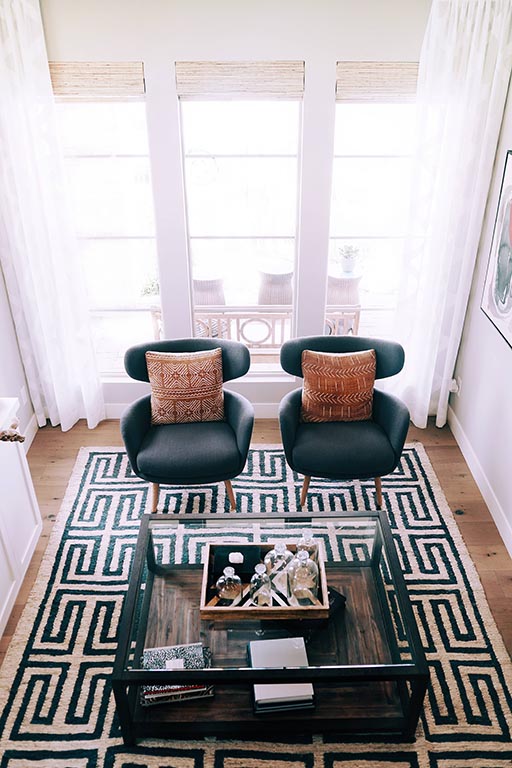
Making the living room a bit modern will capture the eyes when it is small. Modernization starts with simple patterns but is vibrant. Bold, geometric patterns in vibrant colors pack a casual punch in a modern living room where white is painted with neutral tones on the walls and couches, while the saturated red tone stands alone and draws the eye to the floor, making a real statement. The use of golden tones and dark blues in soft furnishings complements the red without overpowering it.
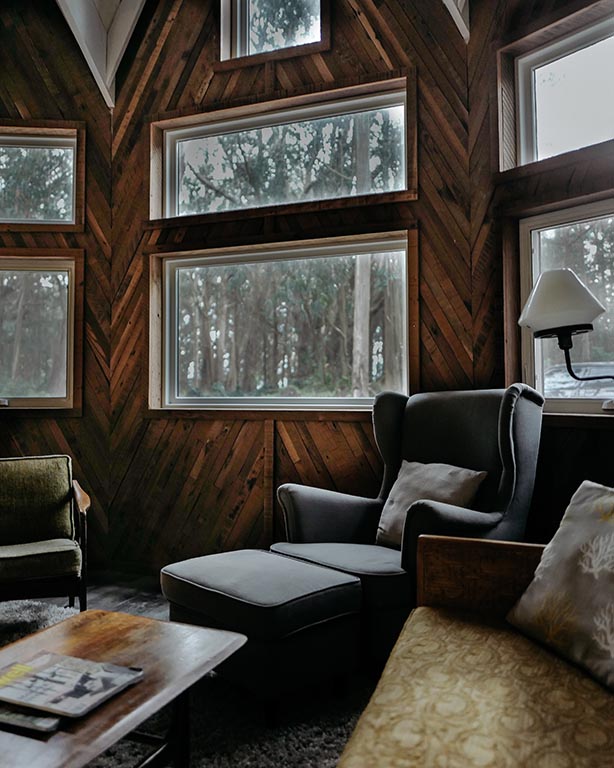
If wall-to-wall carpeting isn’t an option, fully covered carpets can completely wrap around a seating area, making an open space feel intimate. A bit large shag rug creates a defined space and suitable background for mid-century modern furniture.
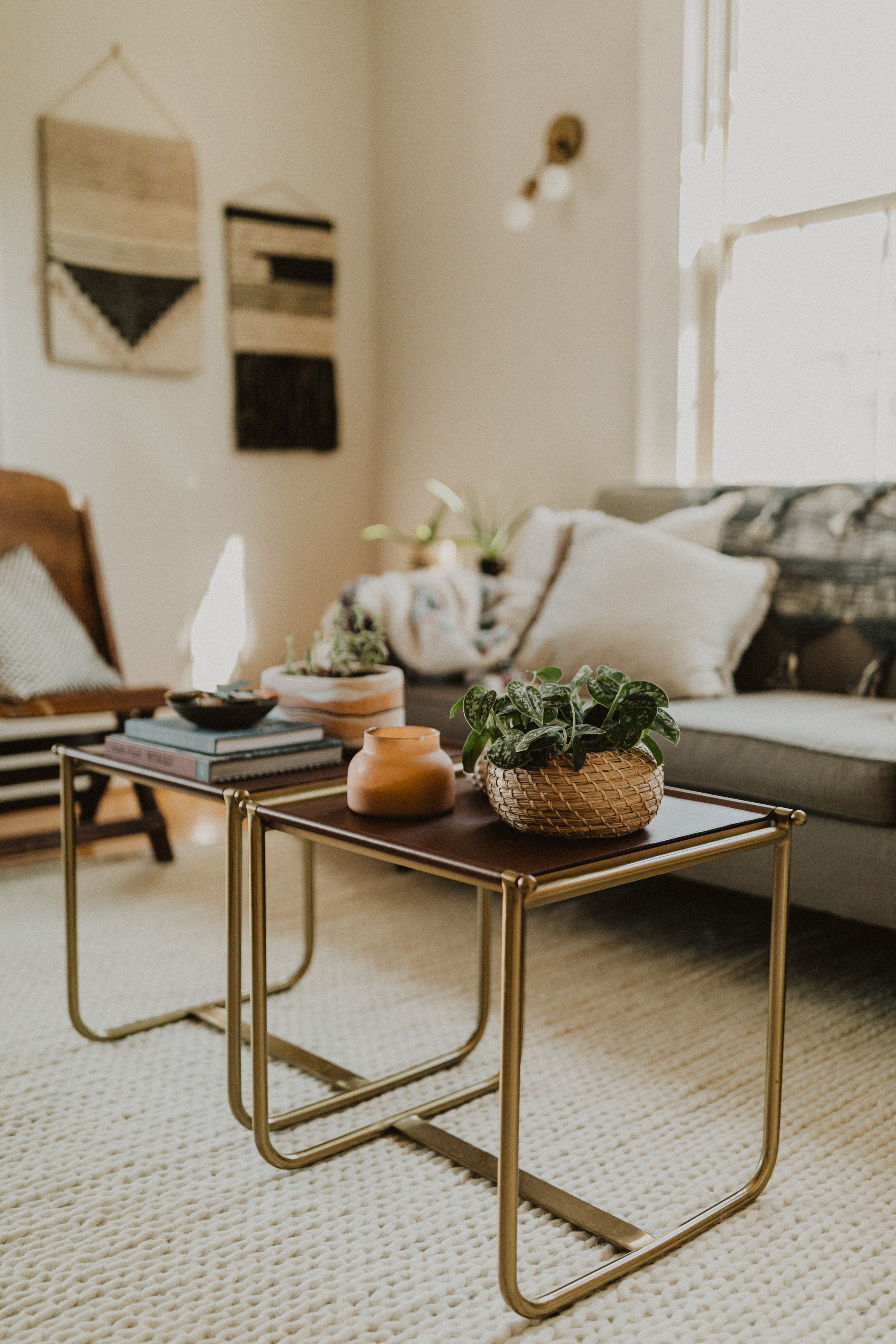
This may sound weird for rug ideas for a small living room and may seem counterintuitive, but use a rug that extends beyond the furniture in each functional space when possible. For example, a rug placed under the sofa, coffee table, and additional seating in a living area will widen the eye and make the living space look larger. On the other hand, a small rug slightly larger than the coffee table can feel like a bath mat, causing the living space to read as limited in size.
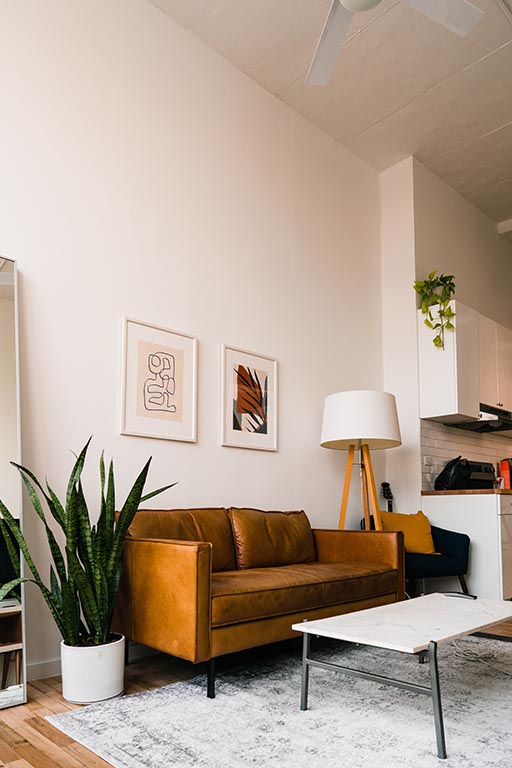
Anchoring a gorgeous four-poster couch requires a decidedly beautiful rug, and a vintage-inspired design is up to the task. With a cream ivory background covered in a traditional pattern accented with pleasant, muted tones, a coastal rug ties the space together. Placing the rug halfway down the couch shows off more of the bold design, adding character to the small but bright living room. The multi-textured surface, reminiscent of ancient mosaics, creates a beautiful contrast.
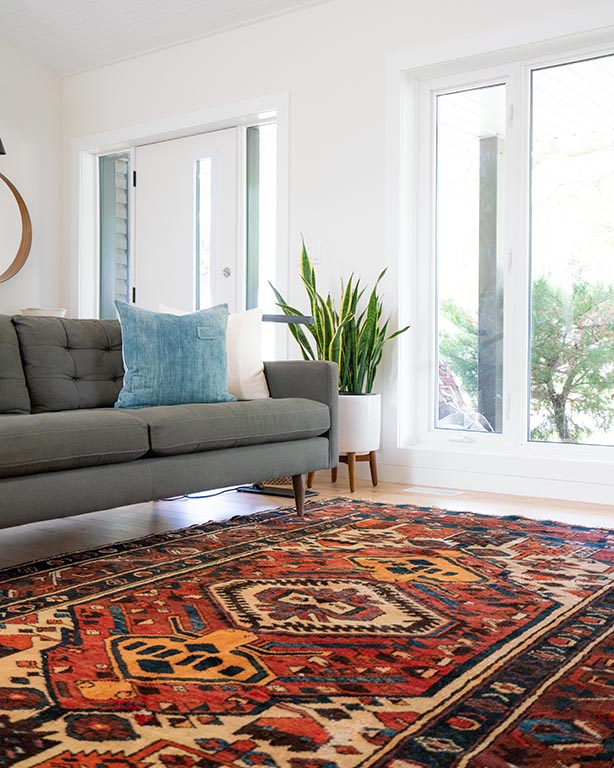
Place a Tibetan rug if you need to have a perfect touch with a relaxing style where tradition meets design. These rugs may create artistic designs and a travel vibe completely different from other rug ideas for a small living room. Add a retro rug in bright pinks, purples, blues, and yellows. Brilliant colors are not overwhelming when they are on the ground. Add a neutral couch and treasure your travels. Finish the look with some indoor plants. Your small bohemian living room will be your new favorite place in your home.
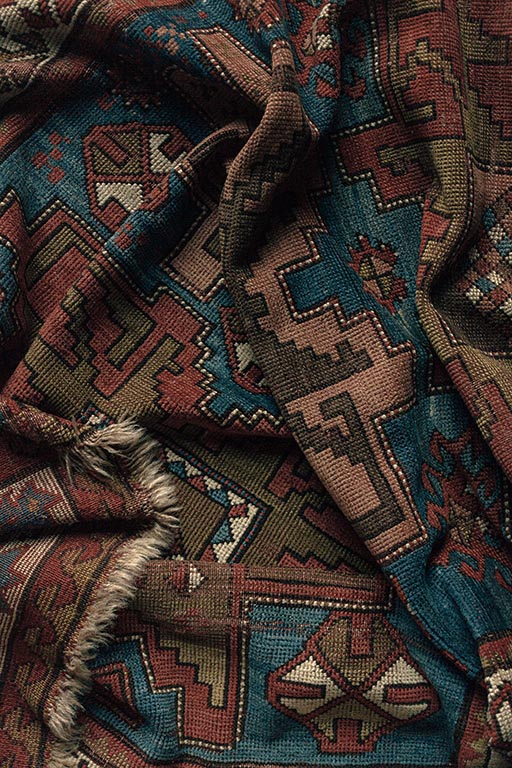
Using contemporary or oriental rug ideas for a small living room never goes out of style. It can be surprisingly versatile in all kinds of houses. There is an Oriental rug for every space with thousands of options in color, fabric, scale, and style, whether you’re looking to accent an English-inspired living room or an Asian royal look. Going monochromatic or neutral with the rest of the room’s decor will be a great decision when designing with oriental rugs. And also, remember to match the colors with furniture and mix the patterns.
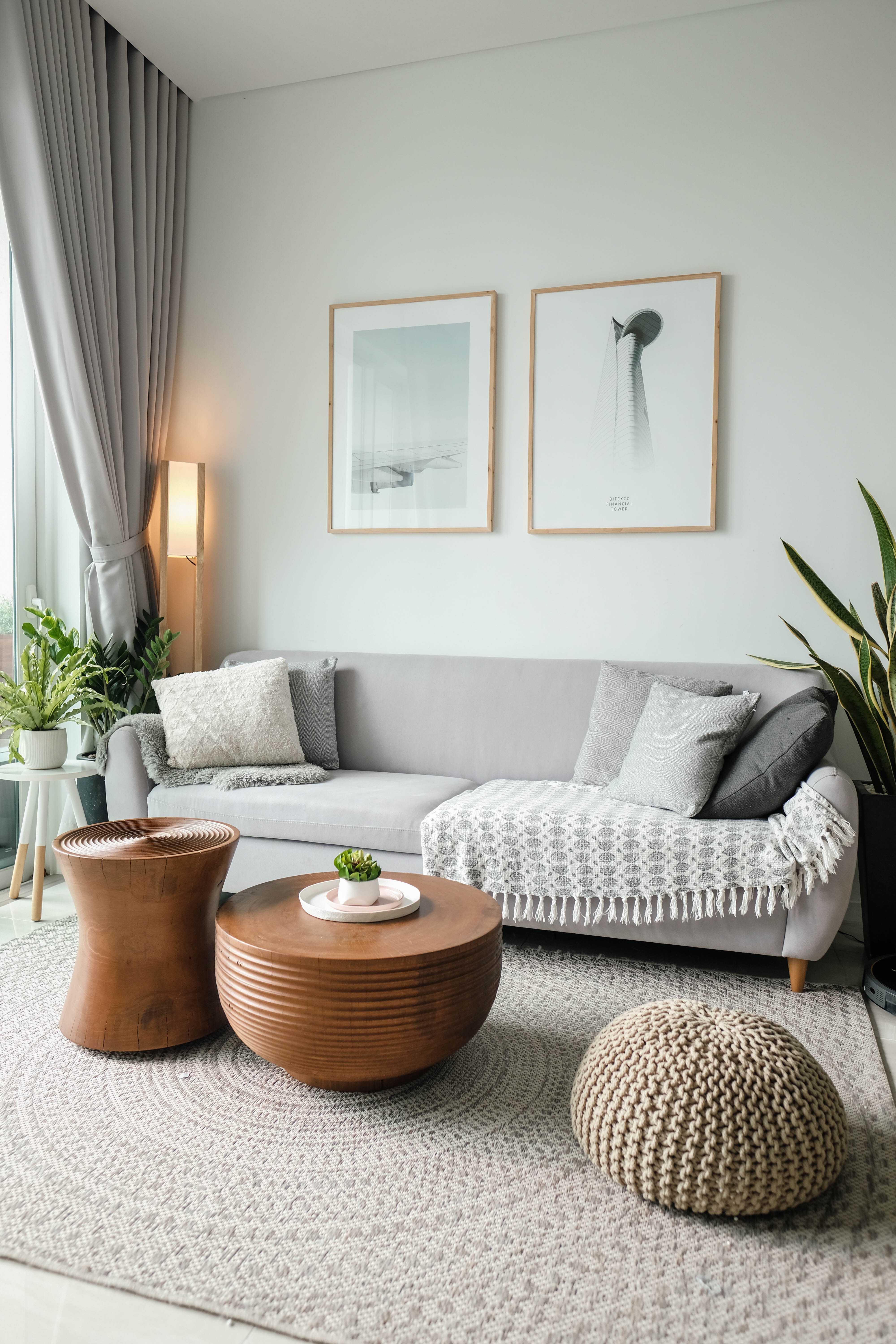
Jute, Sisal, Bamboo, and grass rugs are somewhat exceptional and eco-friendly. Those silky plant fibers give your small living room a naturally soft hand feel and eye-catching textural appeal. Since these rugs are durable and long-lasting, it makes your home perfect for gatherings. If both you and your home are small but busy, placing an eco-friendly rug will give you and handful of benefits. As mentioned, the benefits of eco-friendly rugs are a lot, and you can buy them more reasonably than purchasing synthetic ones. It’s a beautiful option for those who have small spaces, as it pairs well with a lighter color palette.
We have come across many blogs explaining the concerns when buying a rug for your home. Also, we have discussed them all together and sometimes separately. You can read them easily by visiting our blog. There you can find how to select a rug for your living room, bedroom, hallway, etc. So, today the article will explain a missing thing but more important than any others since kitchen rugs are something special. Otherwise, choosing a rug for the kitchen has so many concerns. However, a rug lover might need a perfect rug in the kitchen before starting using the kitchen. The reason is the unusual behavior seen in a kitchen rather than in other places. So, let’s begin the discussion.
You will feel weird when you read the above subtopic. But here, there is something to learn. Mainly the purpose. Understanding the intention of your rug is better than trying different rugs several times and changing.
An area rug in the kitchen would be helpful to reduce the noise in the kitchen. While the other objects like tiles, floors, and windows improve the noises, rugs can absorb them. Apart from that kitchen is also a place where you should work comfortably, and the family members should feel an ultra-beautiful feeling.
The rug should protect against slipping due to high foot traffic in the kitchen. So, kitchen rugs are used to cover the kitchen floor but also to provide comfort, protection, and beauty. So, when constructing rugs for the kitchen, makers focus on those things and use different materials. You have to be aware of those materials for choosing the perfect one. So, let’s discuss the materials in those rugs.
Rugs introduced as indoor-outdoor rugs (usually made of polypropylene) are a good choice because the fibers don’t absorb spills. Cotton or a blend can also be a good choice for small rugs you can put in your washing machine. Natural fibers like sisal or jute are durable and can sometimes be cleaned of stains, while wool is an easy-to-spot natural weave, but each requires more care than a polypropylene rug. Read the care instructions given by your dealer before buying a rug to ensure you’re willing to put in the effort.
Nylon: Nylon is the best synthetic material for rugs and is suitable for the kitchen. Due to its strong and durable features for high footfall and easy to clean, it is also stain resistant and makes the best kitchen rug fiber for a busy space!
Polyester: Polyester is also resistant to fading and dries easily and quickly. It is resistant to water-based stains due to its low absorption level, but oil-based paints are tough to remove from polyester. It is artificial and usually mixed with other fibers but is close to wool in look and feel.
Polypropylene: This is an artificial fiber, but this is the most resistant to stains and wear. It’s very tough and can even be washed with a semi-bleach solution.
Seagrass: Seagrass is a beautiful natural fiber suitable for kitchen rugs. Unlike sisal or jute, it is exceptionally hard-wearing. It’s not soft material, but it’s perfect for a small decorative rug or runner.
Bamboo: Bamboo rugs are another durable natural fiber to take advantage of. It is tough, durable, and gives off a beautiful shine. These rugs are responsibly harvested and provide a beautiful finished product.
The materials mentioned above are the best choices for kitchen rugs of their accessible clean, durability, and foot-resistant features. However, it isn’t enough considering the material; we should concern ourselves about the size, the backing(potential of slipping), and the decorating concerns. Let’s look at them.
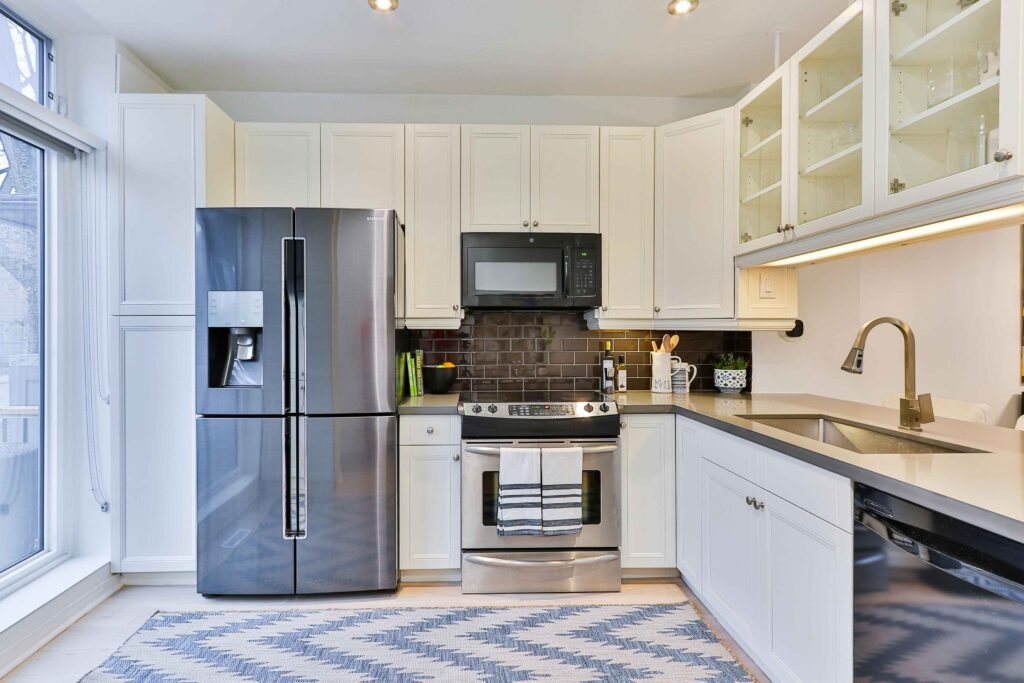
The size of the rug you pick for the kitchen may depend on the area of the floor that you need to cover, the shape of the area you need to cover, and the style you prefer. Faber Rug Inc can cut and bind any size rug you need. We can measure and figure out the perfect size carpet for your kitchen.
Ideal and popular sizes of kitchen rugs include traditional runners (2.5 x 8 or 12 feet), 2×3, 4×6, and 5×8. Includes traditional runners (2.5 x 8 or 12 feet), 2×3, 4×6 and 5×8.
Regardless of the size and shape of your kitchen, the space in front of the kitchen sink is the best, most functional place for your kitchen rug. That’s where we’ll be standing for long periods, so the extra cushion there really helps.
Large kitchens:- If you have over 200 square feet of a large kitchen, think about placing a runner rug above 5’x7 ′, ‘3×5’. If your kitchen is shaped like an island, you can place two rugs on either side.
More tips
Medium kitchens:- Choose a small rug when the place is medium in size. According to your kitchen layout, a smaller rug such as a 5’x7′, 3’x5′, or 2.5’x7′ kitchen runner may work well and save floor space. Open.
More tips
Small kitchens:- A small kitchen can quickly feel cluttered, and adding a rug and pattern can add to it. However, the correct type of rug can add warmth and personality to an otherwise utilitarian space. If you decide to add a rug, choose a small 2’x3′ or 3’x5′ rug or a short kitchen runner like 2.5’x7′, and place it in front of the sink.
Water, oil, or grease tend to make the kitchen slippery. To keep your rug from slipping and your feet comfortable during prep work, find a good rug pad with a backing that adds some spring but doesn’t slip on it.
When it comes to covering the floor of your kitchen where you prepare food for your loved ones, color is important. Make sure you pick a color that you like that is consistent with your kitchen’s overall color scheme and design.
Ideally, it would be okay if you did not choose a light-colored rug for your kitchen, as these tend to deliver stains more quickly and start to look dirty.
If your entire kitchen is on a light-colored floor, you can have a dark-colored multi-colored rug that still fits well with the rest of the decor.
Every rug lover has multiple choices. One can love traditional rugs, another one loves modern styles, and some are in love with Persian and oriental rugs. But, only a few of them care about the material and process. Only a palm-full of people know how to make a rug or how it is processed. If one who doesn’t care is reading this, he might ignore “why is it important to know how a rug is made?” and just enough if we can buy it from the shop. If you don’t mind, it is better to know the hidden story of everything you like than just observing and taking decisions. So go through this article, learn how to make a rug, and think about the next story when choosing a carpet.
Rug-making started a long time ago. If you refer to our previous blog on the history of rugs, you can get an obvious idea. However, there are four different methods of constructing rugs so far. Let me introduce them to you.
How do you think this started? No doubts. You will answer hands. Yes. Handmade rugs were the first and the foundation for the rug industry in the world. So, the very first method of rug making is hand-knotting.
This old technology has been used for over 1000 years. These rugs, made famous by Turkish and Persian artisans, are woven into sheer fabrics. The rugs are made by knotting the yarn crosswise (threads on the carpet vertically) and tightly wrapped around a wooden or metal frame (loom).
The Knotting process is prolonged and requires years of training and experience. The average weaver can knit about 10,000 knots a day. The leading carpet makers are artists in the true sense of the word, and their work should be treated the same way.
This technique uses a tufting gun that speeds up the rug-making process. This makes it easier to create hand-tufted rugs than other handmade or slow-moving techniques. On the other hand, manufacturers can quickly produce the highest quality hand-tufted rugs compared to other handmade methods.
This technology was developed as an alternative to hand rugs which greatly accelerates the production of rugs. First, the design is stencilled into a piece of canvas that is tightly stretched across a frame. Then, using a tufting gun, the thread is sent across the canvas into a ‘V’ shape. Once the tufting is done, the rug is removed from the frame and glued to the back to hide the tufting end. They are cheaper than their hand-tied cousins due to less labour and skill requirements.
In modern times, machine making has spread throughout the industry and is perhaps the most accessible of the rug-making techniques. Machines capable of weaving, weaving, hooks and tufting can produce handmade mattresses in a short period of time.
The fastest and most efficient method of making rugs using the latest machinery and technology, machine-made rugs are built through thousands of reels fed into one giant mechanical loom that can be quickly carpeted to the selected pattern. Although there are limits to the amount of color used on one rug (usually 8-10 colors), several rugs can be made at once. Machine-made rugs are affordable and of high quality and service, making them an affordable luxury item in your home.
Produces rugs without the need for the fabric to build a flat weave. These are the pattern and foundation of a carpet, and since they have no backing, you can use either side when you lay them down. Classifying them as flat results from their lack of piles and smooth texture, which also contributes to their durability. Automatic loom machines can create a variety of intricate patterns with precision through the application of computer-aided design technology. The machines minimize the possible defects in the carpet as a result.
For this technique, you will need a sewing machine. Built on a two-layer structure of vertical threads, the rugmaker places a horizontal weave between the upper and lower battle plates. The canopy has a movable front part called a beater, which pulls the fabric maker towards the growing carpet to press each extra line of the weft. This way, no large blanks could damage the fabric’s integrity once it is finished.
If the professional changes the process slightly, the flat canopy may have a more stacked surface. The yarn is piled up by placing a tube or rod between the two looms. The rug makers then made alternate rods and weaved them on the rug, and once they were finished, they could be left alone, or the loops could be cut.
Choosing a carpet can be a fun and exciting task. But carpet installation is can be difficult and not always easy. That is why it is better to choose an experienced person or a company.
Carpets are not cheap, so you need to hire a professional if you are unsure how to install them properly. Professional carpet installers are good at how to properly install the different construction of carpets.
A skilled and experienced service provider will take a number of steps to complete the task. However, choosing the right carpet for your purpose is entirely in your hand. Refer to our previous blog about selecting the best rug for your home. But, a customer-friendly service provider, like the staff at Faber Rug Co. will help you with the process. If you need to do this yourself, this guide will ultimately help you do things alone.
Here are the next steps.
Carpet removing is also a step-by-step process. This should be done very carefully to ensure that the floor for the new carpet is smooth and not damaged.
If you do not entrust the job to an experienced person or team, you will need to inspect the floors and fix any problems before installing a new carpet or floor.
Carpet installation is a way to enhance the atmosphere of a room. At the same time, they offer comfort undoubtedly. However, laying a pad may improve comfort.
Next, the old carpet cushion will be removed and replaced with the new carpet padding, making a big difference in the feeling and functionality of your new carpet. There are various types of pad. Rubber is the softest and a little bouncy, Bonded is another type contractors use in new home but it loses its density quickly and can leave you feeling the carpet not being as soft as it originally felt. The best choice Faber Rug recommends is Nova pad which is dense and will last a long time. Its firm and will enhance the feel of your carpet and the life expectancy.
To properly install here are a few steps to follow.
It is best to use a good quality, domestic metal tape to do this job well. Measure the lengths and breadths and calculate the area. Then cut the piece of the underlying pad to fit the surface perfectly. The pad should fit exactly from one tack strip to the next. Pad usually comes in 6′ widths. You will lay a series of breaths to cover the floor and use a utility knife to cut the pad close tot he tack strip not leaving any gaps. If its being installed on a wood floor then staples can be used to secure it to the floor. If the floor is concrete then it may be glued down.
Before you begin, you should do a series of checks on the area where you will lay the carpet floor. First, make sure the surface is clean. If there is excess dust, you can use a vacuum cleaner and be sure to remove nails or small objects that have stuck to the surface.
If you can, temporarily extract the doors from their frames, this will speed up your work, but do not force it if circumstances do not allow you to do so. Often when replacing your carpet with a new one doors may need to be shaved on the bottom in order for them to close properly. Take this into consideration when picking your new carpet. You may need a contractor to trim your doors if you or the installers dont perform this task.
The tackle bar creates a carpeted frame. When placing the strip, make sure the pins face the wall. Position and nail it to the floor depending on the thickness of the carpet. For concrete floors, use glue.
It seems simple, but be sure not to rush things. Laying your carpet and floor in the wrong way will create a crooked carpet. First, observe the direction of the floorboards and adjust the angles below as you place them.
The carpet pieces should be larger than the relevant room in a small amount, covering up to six inches. This cover cutting can be tricky, and it is imperative to cut it correctly when replacing the carpet. Experienced installers accomplish it precisely the first time, and the new carpet will prevent wastage or damage. This should be planned when you are measuring for carpet installation.
Grab a Pencil and a paper. Then sketch the area where you are going to lay the carpet. No need for a perfect diagram, but you will need accurate measurements.
Now measure all the lengths and width tape and write down your dimensions on your diagram.
Calculate the area (length*width) and buy the necessary size of carpet. Some store sell it by the square foot or square yard.
Note:- Remember to keep additional lengths for the seams (six inches)unless you need to match a pattern then you may need more carpet.
Lay the new carpet on the padding. It’s really simple. But, the hardest part is coming up.
Most rooms require more than one piece of carpet to cover the room. The popular way to do this is to cut the carpet from wall to wall to ensure that the pattern fits correctly. The carpet is cut with great precision, so the pattern is straight on the wall.
Seaming tape is used to join two piece of carpet together in a room that is larger than the width of the carpet chosen. You use a carpet iron to heat the tape that has glue on it and it connects the two piece of carpet together on the backing. Some carpets need to be sealed on the edge first before the seam can be made as not to unravel.
To finish the installation, first, stretch the carpet using a “knee kicker” and then spread the carpet along each wall to attach to the tack strip and tuck the carpet between the baseboard and the tack strip. Trim the carpet close but leave enough to tuck in with a chisel.
New carpets and rug padding, or carpet cushions, feel luxurious and satisfying. It is a gift for your feet and can express your family’s personality and lifestyle. Luxury designs can give you performance and value whatever carpet you want. So, it is better to go to a new carpet installation when your rugs are old and don’t look or perform like they used to.
Now enjoy your new carpet and relax, installation is hard work.
